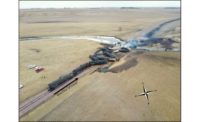Few pleased by new DOT rule on tank cars carrying hazmat

 Both safety advocates and the railroad industry are expressing disappointment with new rules announced Friday by the U.S. Department of Transportation that are intended improve the safety of rail tank cars carrying crude oil and other flammable liquids.
Both safety advocates and the railroad industry are expressing disappointment with new rules announced Friday by the U.S. Department of Transportation that are intended improve the safety of rail tank cars carrying crude oil and other flammable liquids.
The final rule, developed by the Pipeline and Hazardous Materials Safety Administration (PHMSA) and Federal Railroad Administration (FRA), in coordination with Canada, focuses on safety improvements that are designed to prevent accidents, mitigate consequences in the event of an accident, and support emergency response. Canada’s Minister of Transport, Lisa Raitts said Canada’s new tank car standards will align with the U.S. standard.
The rule:
- Unveils a new, enhanced tank car standard and an aggressive, risk-based retrofitting schedule for older tank cars carrying crude oil and ethanol;
- Requires a new braking standard for certain trains that will offer a superior level of safety by potentially reducing the severity of an accident, and the “pile-up effect”;
- Designates new operational protocols for trains transporting large volumes of flammable liquids, such as routing requirements, speed restrictions, and information for local government agencies; and
- Provides new sampling and testing requirements to improve classification of energy products placed into transport.
But what about the Bakken crude?
Safety advocates said that by not setting a standard for volatility, the rule fails to address the dangers of the high-volatility Bakken crude oil that has been involved in a number of deadly railway accidents involving explosions. A train carrying Bakken crude oil derailed and exploded in Lac Megantic, Ontario in July, 2013, killing 47 people -- one of many incidents involving the substance.
“These rules do not go far enough in addressing the safety concerns posed by trains transporting highly volatile crude oil through the heart of our communities,” said Rep. Mike Thompson, D-St. Helena. “We need to put robust, comprehensive safety measures in place that will help make sure communities are safe, rail cars meet the strongest possible standards, and first responders are prepared in the event of an emergency. DOT’s rules do not sufficiently address these issues and so Congress should act to put safety measures in place.”
"No substantial evidence"
While it applauded the enhanced design standards called for in the rule, the Association of American Railroads (AAR) was sharply critical of the requirement for the use of ECP brakes -- or the imposition of a 30 mph speed limit.
“First and foremost, the DOT has no substantial evidence to support a safety justification for mandating ECP brakes, which will not prevent accidents,” said Edward R. Hamberger, AAR president and CEO. “The DOT couldn’t make a safety case for ECP but forged ahead anyhow.”
Hamberger said a 30 mph speed limit "will compromise network capacity by at least 30 percent. The far-reaching effects of this decision will be felt by freight and passenger customers alike. Slow-moving trains will back up the entire rail system.”
The NTSB, however...
National Transportation Safety Board (NTSB) Chairman Christopher A. Hart said he was pleased with the rule, which addressed one of the issues on the NTSB’s Most Wanted List of transportation improvements.
“The Board has long been concerned about the safety of rail transportation of hazardous materials,” said Hart. “This new rule is a significant step toward improving the safety of transporting crude oil and ethanol by rail.”
Hart added that the Board will be analyzing the rule to see how it aligns with the NTSB’s safety recommendations and will be releasing the results in the near future.
Looking for a reprint of this article?
From high-res PDFs to custom plaques, order your copy today!





